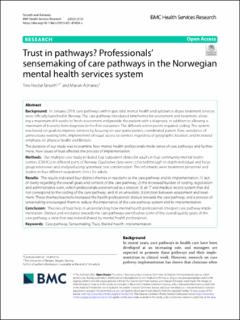| dc.contributor.author | Tørseth, Tine Nesbø | |
| dc.contributor.author | Ådnanes, Marian | |
| dc.date.accessioned | 2022-08-05T11:20:25Z | |
| dc.date.available | 2022-08-05T11:20:25Z | |
| dc.date.created | 2022-01-06T09:47:05Z | |
| dc.date.issued | 2022 | |
| dc.identifier.issn | 1472-6963 | |
| dc.identifier.uri | https://hdl.handle.net/11250/3010357 | |
| dc.description.abstract | Background: In January 2019, care pathways within specialist mental health and substance abuse treatment services were officially launched in Norway. The care pathway introduced timeframes for assessment and treatment, allowing a maximum of 6 weeks to finish assessment and provide the patient with a diagnosis, in addition to allowing a maximum of 6 weeks from diagnosis to the first evaluation. The different action points required coding. The system was based on goals to improve services by focusing on user participation, coordinated patient flow, avoidance of unnecessary waiting time, improvement of equal access to services regardless of geographic location, and increased emphasis on physical health and lifestyle.
The purpose of our study was to examine how mental health professionals made sense of care pathways and furthermore, how issues of trust affected the process of implementation.
Methods: Our multiple case study included four outpatient clinics for adults in four community mental health centres (CMHCs) in different parts of Norway. Qualitative data were collected through in-depth individual and focus group interviews and analysed using systematic text condensation. The informants were treatment personnel and leaders in four different outpatient clinics for adults.
Results: The results indicated four distinct themes or reactions to the care pathway and its implementation: 1) lack of clarity regarding the overall goals and content of the care pathway; 2) the increased burden of coding, registration and administrative work, which professionals experienced as a stressor; 3) an IT and medical record system that did not correspond to the coding of the care pathway; and 4) an unrealistic distinction between assessment and treatment. These themes/reactions increased the health professionals’ distrust towards the care pathway, and a process of sensemaking encouraged them to reduce the importance of the care pathway system and its implementation.
Conclusion: Theories of trust help in understanding how mental health professionals interpret care pathway implementation. Distrust and resistance towards the care pathways overshadow some of the overall quality goals of the care pathway, a view that was indeed shared by mental health professionals. | en_US |
| dc.language.iso | eng | en_US |
| dc.publisher | BioMed Central | en_US |
| dc.rights | Navngivelse 4.0 Internasjonal | * |
| dc.rights.uri | http://creativecommons.org/licenses/by/4.0/deed.no | * |
| dc.title | Trust in pathways? Professionals’ sensemaking of care pathways in the Norwegian mental health services system. | en_US |
| dc.type | Journal article | en_US |
| dc.type | Peer reviewed | en_US |
| dc.description.version | publishedVersion | en_US |
| dc.rights.holder | Copyright 2022 The Author(s) | en_US |
| dc.source.articlenumber | 33 | en_US |
| cristin.ispublished | true | |
| cristin.fulltext | original | |
| cristin.qualitycode | 2 | |
| dc.identifier.doi | 10.1186/s12913-021-07424-x | |
| dc.identifier.cristin | 1975646 | |
| dc.source.journal | BMC Health Services Research | en_US |
| dc.identifier.citation | BMC Health Services Research. 2022, 22, 33. | en_US |
| dc.source.volume | 22 | en_US |

